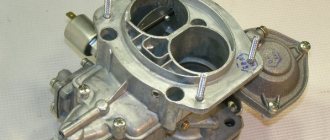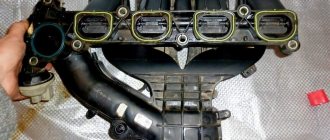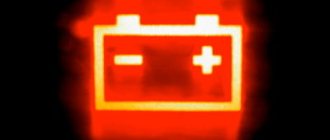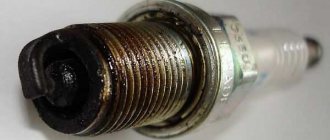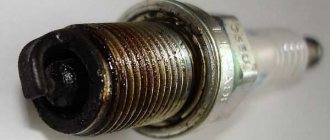Gasoline prices continue to increase. This fact encourages more and more vehicle owners to switch to alternative fuels. Electric cars have a number of advantages. However, even talking about large cities, the number of charging stations for electric vehicles is minimal. The operation of private electric transport is complicated. Gas remains the optimal replacement for gasoline. Installing gas equipment will provide significant savings to the family budget with regular use of vehicles.
Naturally, for correct operation, fine tuning of the HBO and subsequent attention to technical nuances are necessary. If the speed on gas drops, there may be several reasons. Below we describe the most common approaches to eliminating the described problem.
Problem - floating idle speed when running on gas
A common problem is unstable operation of the internal combustion engine on gas at idle speed. What malfunctions do HBO have in such cases? Let's try to understand this issue.
There can be two reasons when the speed on gas fluctuates: either it “does not burn,” that is, the lean fuel mixture does not ignite well; or interruptions in spark. With the second case, everything is simple, because the circle of culprits is not so wide - a switch, armored wires or spark plugs. But in the case of a lean mixture, the search may take longer.
Description of the problem
The malfunction manifests itself in jerking and floating engine speed, when the tachometer needle can jump from 500 rpm to 1500 rpm and even higher. During normal engine operation, the needle first rises to a level of 2000–2500 rpm in warm-up mode, and then should remain at 700–900 rpm. If there is no tachometer on the dashboard, floating speed can be determined by the sound of the power unit (the roar of the engine either increases or decreases), as well as by the vibrations penetrating the cabin.
As a rule, after the engine warms up, the problem disappears. However, at the next cold start, exactly the same picture occurs: the speed of the power unit again jumps in a wide range. And if the first time can still be attributed to an accident, then the second and subsequent cases are a reason to contact for repairs or to fix the problem yourself.
Gas injectors
If it is not possible to connect to the computer, then you can pinch the hoses leading from each injector to the insert in turn, and thus detect the malfunction. You should also check whether an impulse is received from the ECU to the injectors, turning them off alternately. Possible problems and malfunctions:
- Natural wear and tear of the GF or its contamination with foreign inclusions in the fuel;
- Initially injectors that do not match the specific engine;
- No impulse is received (or is received intermittently) from the ECU;
- Air leakage, which depletes the air-fuel mixture on the way to the insertion or at the insertion point into the manifold;
- Air leakage through a leaky manifold gasket - this defect is also common.
In the first two cases, the injectors are replaced as non-conforming or repaired (cleaned, calibrated). Deposits of 5 microns reduce the performance of the GF by 20%, which affects engine operation. To avoid problems in the future, you should carefully choose a gas filling station and change the fine filter more often.
The main reasons for this problem include:
— clogged gas injectors or their miscalibration;
— presence of air leaks;
— unstable power supply to the LPG control unit;
— problems with the throttle and idle speed control;
— unadjusted valves;
— wear of the CPG.
If the problem was caused by clogged gas injectors, then the solution is to either clean the injectors or replace them with new ones. In turn, after a certain period of time, cheap injectors may begin to inject fuel into the cylinders differently. To avoid this, the injectors must be calibrated after every 30 thousand kilometers traveled. In addition, the injectors may initially not be suitable for a specific engine, and therefore must also be replaced.
A problem with unstable power supply to the control unit leads to malfunctions in the operation of 4th generation gas equipment of different brands (Lovato, Digitronic, etc.). Due to a lack of power, the unit cannot transmit a pulse of full force to open the injectors. This problem is detected by checking the voltage of the gas block: if it drops by less than 12.3 Volts, then you should check the terminals, battery and charge of the generator.
To avoid problems with the throttle and idle air control, it is necessary to regularly clean the throttle assembly and change the idle air sensors. As for the reason associated with unadjusted valves, it is eliminated by specialists from service centers. According to the regulations, a number of engines (for example, gazelle: 405 engine) require valve adjustment after every 40 thousand kilometers traveled. If you neglect this, the engine will work with some interruptions.
Reducer-evaporator
Pay attention to the pressure when the speed increases sharply. A drop of more than 20% indicates either a leak, a faulty valve, or a narrowing of the gas passage channels. Traction disappears, the engine stalls when the gearshift lever is switched to neutral. The main reason is pollution. It can be solved by repairing the gearbox.
Common places for air leaks
- Loose clamps on pipes and vacuum hoses.
- Cracks in rubber hoses and pipes. Most often found near clamps, in places of contact with elements of attachments.
- Broken brake booster diaphragm.
- Leaking vacuum valves (PCV, EGR, absorber purge valve). The cause of the leak is a leaky membrane, but cracks in the housing should not be ruled out. If your car is equipped with HBO, check the vacuum corrector.
On Japanese-made cars, when troubleshooting, pay attention to the system of vacuum valves involved in adjusting the warm-up speed and opening the additional air channels
- A crack in the plastic intake manifold due to a manufacturing defect or mechanical damage. Often such collectors consist of several elements assembled on sealing gaskets. If the gaskets become tanned due to temperature loads in the compressed state, air will be sucked into the intake manifold through them.
- Loose fit of the intake manifold to the cylinder head.
- Worn or incorrectly installed fuel injector O-rings.
- Wear of the throttle valve rotation axis in the housing (very common on Mitsubishi Lancer 9).
Other possible reasons:
- Low level of coolant - lack of antifreeze can cause underheating of the gearbox, as a result - the liquefied gas does not partially turn into steam;
- If problems with idle speed coincide with a sharp change in weather, then additional idle adjustments on the gearbox may be required;
- With regular short runs, condensation may accumulate in the gearbox, interfering with the normal operation of the unit, so it would not hurt to check this fact.
Dips during sudden gas changes
- Gas injectors are not calibrated correctly.
- The gas filter is clogged.
- The gas pressure in the reducer is insufficient.
- Problem with gas lines.
If, when switching to the engine, it starts to “go bad”, most likely the problem is in a faulty gas system , in this case, switch back to gasoline and continue driving it until the reasons for the interruptions in the operation of the internal combustion engine are established. Repairing gas equipment with your own hands is highly undesirable unless you are well versed in gas equipment and have all the necessary equipment to carry out repair work. In all other cases, we recommend contacting specialists or the service station that installed this gas equipment.
Thank you for your attention, see you again at HBOshnik. Bye!
Filters
Filters need to be replaced periodically. Typically the interval is 10 thousand km. However, as practice shows, sometimes it is because of a clogged filter that the speed fluctuates when the car is running on gas. This applies to both the coarse filter and the fine filter. In the first case, you will need to remove the filter for disassembly. Fine filters, as a rule, cannot be repaired and must be replaced.
Does the rpm fluctuate after cleaning the throttle body?
Firstly, an error may have been made during connection. Secondly, calibration is necessary.
The system can be trained manually without special equipment. It consists of unscrewing the negative terminal from the battery for 10 minutes. This will reset the settings to factory settings. When the terminal is returned and the car is started, everything returns to normal. Adaptation algorithm without a PC:
- heat the “heart” of your vehicle and turn it off;
- wait 10 seconds;
- turn on the ignition for 3 seconds;
- press the gas pedal all the way and release it in 1 second, do this 5 times (control yourself with a metronome or stopwatch so as not to lose track);
- wait 7 seconds;
- press the accelerator to the floor and hold it until the check light on the dashboard lights up (first flashes, then stays on);
- wait 3 seconds and release the gas;
- start the unit and check it.
After removing the battery, the speed fluctuates or the engine stalls - we suggest doing the following (on a warmed-up power unit): remove the “-” terminal from the battery and return it after 40 seconds, then set the right pedal at 2100 rpm. (+/- 100) and keep at this level for at least two minutes. If you carry out these manipulations “cold”, then hold in this position for at least ten minutes.
Unstable “heart” activity (the car jerks) of your iron friend when moving is dangerous, so it is important to quickly understand and fix the problem. Sources of failures:
- air filter clogged;
- inoperative remote control position sensor;
- burnt out exhaust valve;
- clogged catalyst;
- failed lambda probe;
- broken spark plugs.
Also, such factors lead to the car being difficult to start.
Why does the car stall after changing the gas?
Max » 01/17/2003 6:03
Starcon » 01/17/2003 8:34
90% – alarm and auto start installation curve. Either something was included in the wrong place, or something was violated during installation.
Regarding XX: indeed, this system is one of the most capricious on all machines, including Cefiro. It can be adjusted normally, as I now know from my own experience, only at a proprietary station with Consult. BUT: problems with the XX system progress quite slowly and do not arise overnight. And it rarely happens that an engine behaves so unstable. I had a case, I filled the spark plugs, and two cylinders (if not three) did not work. But at the same time, the control unit still maintained the required 700 rpm!
So your installers probably broke some kind of chain.
signaling
komaroff » 01/18/2003 2:50
Mikhal777 » 01/19/2003 21:49
Fight! You won’t believe it, but it was all like this: After I left the service station (where I installed the signal), I pressed the gas and drove 100 m. I pressed the brake, and the revolutions dropped from 1000 to 200 and it completely stalled. I started it - it held 700 exactly, I drove off, pressed the brake, again the same crap. Damn, I think the freaks don’t do everything through the %oops! I’ve already turned back, but it seems like it doesn’t stall when braking, but it drops slightly, but then the trachometer needle reaches 500-600. Okay, I think it will be tomorrow, and I’ll stop by tomorrow. Morning, the thermometer is -10, (after yesterday’s 0 -2), well, let me think I’ll start the car from the balcony, like I’m “fashionable” now, so what? Otherwise it won't even start! The battery is completely dead. Well, I think they gave me my battery at the service station when they were setting up the “music” (even when I was installing the alarm system, I installed an amplifier, a sub, and a new “head”, well, in general, “I changed the music”), but I didn’t mind changing it anyway (I was still dear). So we bought a new battery, 75 amp. hours, like a battaleyka gud (called ATLAS like Karey - 2200 re.), well, they installed it, well, it started, well, it drove EVERYTHING OK! The revolutions are 700, you slow down, well, they drop, but everything seems to be within limits. Here's the story. But they didn’t touch SENSOR XX at the service station, they attached it to the trachtometer, or at least that’s what they said.
THANK YOU ALL FOR your responses to my Help. I still tore the installers’ ears off for my nerves and for the battery!
ECU - do not rule out a “brain glitch” of the car
If you find that the car’s speed is fluctuating after recently replacing a failed sensor, then you should not rush to draw conclusions. To begin with, it is recommended to reset the errors in the electronic control unit, and only after that check that the problem has been resolved.
To clear the ECU memory, you can disconnect the battery terminal for 5 minutes, but this method is not recommended. In this case, you will not know what errors were noticed by the ECU, and you will not be able to begin eliminating them. That is why it is recommended to clear memory through a connected computer. It is first necessary to count all errors and, if possible, resort to eliminating them. If the faults have been eliminated, then you can safely clear the memory and continue operating the car.
This is interesting! Lanos cars have a self-diagnosis mode, so each owner, if necessary, can read the error codes and resort to troubleshooting the corresponding faults.
The speed on a Lanos can also fluctuate due to poor ground contact of the ECU. Very often, many owners (not only Lanos cars) do not pay due attention to this factor, and until they replace all the sensors, they do not check the condition of the ECU ground wire.
On Lanos, the ECU is located on the right side near the passenger’s feet. Ground wires in the amount of 5 pieces from the ECU terminals - B10, C12, C13, A12 and D1 go under the hood and are connected into a twist, which is located in the corrugation. More precisely:
- The wire from pin B10 goes into connector C104, after which it goes to engine ground G105.
- Wires C12, C13, A12 and D1 are connected to each other in a twist, from which a thick wire extends to connector C104 and is connected to the ground of the G104 engine.
The essence of the problem is that the “mass” wires are connected together with other consumers, which increases the load. It is this weak point on Lanos that is the reason that due to the load of the “mass” wire, the revolutions begin to float. The problem can be solved by moving the ECU ground to the car body or by placing it on the sensor mounting stud, as shown in the photo.
In this case, it is very important that the ground contact is free of oxidation. It is possible that internal glitches of the ECU on Lanos may occur, but in this case it is recommended to simply unplug the battery terminal for 5 minutes and then connect it back
This is interesting! To eliminate the possibility of ECU failure, it is necessary to use a working battery, and also eliminate the use of electric compressors for inflating tires connected to the cigarette lighter. When the compressor is connected in this way, the load on the electrical network increases, so there is a high probability that the ECU may fail. It is recommended to give preference to compressors that are connected to the battery terminals.
Adjusting gas flow to LPG 2
It comes down to setting up gas equipment to reduce fuel costs. The issue of high gas consumption of 2nd generation HBO gas on a carburetor still remains relevant, since such machines are still found among modern injection and turbocharged models. The main thing in this case is the adjustment of the evaporator reducer.
According to gas equipment installers, most problems are associated with this particular component of the system.
Before starting the adjustment, make sure that there are no other serious problems: compression indicator, tightness of the intake tract, condition of the electrical wiring and spark plug contacts. If everything is in order with this, then you can start working with the gas pressure control unit. Its main function is to adjust the amount of mixture passed through the gas valve.
The adjustment steps directly depend on the design of the gearbox. Most of them contain 2 screws: idle and for adjusting a special spring. This fully applies to vacuum units installed in systems of 1st and 2nd generations. The whole process comes down to sequential rotation of the screws: first - idle speed, then sensitivity. The algorithm is as follows: fully open the dispenser, tighten the first screw all the way, then loosen it by 4-5 turns. Set the second screw to the middle position.
First, the engine is started on the main fuel, warming it up well, and only after that do they begin to debug the gearbox. The revolutions must be kept at 2 thousand per minute, while simultaneously rotating the idle screw.
The purpose of the operation is to understand how to reduce gas consumption on the 2nd generation LPG and achieve an adequate engine response to sudden depressing of the gas pedal. Until this succeeds, the steps are repeated.
You might be interested >> Adjusting the gas system on a carburetor engine


